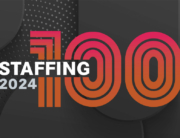While advancements in technology are creating opportunities to run a well-oiled and efficient organization, it is a continuous challenge for businesses to stay abreast of latest technological trends, cutting through the noise and zeroing in on what actually provides value.
Staffing Industry Analysts’ research shows that compared with other industries, technology spend in the staffing industry is below average both as a percentage of revenue and per full- time equivalent employee. The global average across all industries, according to Gartner, is 4.5 percent of revenue.
But there are key areas that staffing firms should focus on to remain competitive and in the game:
- Better efficiency and effectiveness through IT consolidation and improved infrastructure and services.
- Use of fiber-optic infrastructure for better telecommunications bandwidth.
- Outsourcing of infrastructure, platform services and application services to the cloud and transition to web browser delivery and away from thin client solutions.
- Mobile access and the use of mobile applications for anytime, anywhere connectivity.
- Ensuring social media channels are natively incorporated into the front-office application and that various databases can be simultaneously searched.
Essentially, these trends indicate four main points: mobility, big data, cloud and security. All four are inter-related and hard to achieve individually. While mobile apps have reached a level of maturity in the consumer market, the same has not happened in the business world yet — at least not in every business. It’s not as simple as taking what you do and putting it on a mobile device; significant changes have to take effect to make it happen.
The cloud is necessary because it makes data accessible via a mobile platform. And security cuts across all three. Once data are pulled from various entities, including social media sites, security implications have to be considered. Every single investment in any of these areas requires an investment in an infrastructure to protect the organization. As a result, many chief information officers end up with one strategy that incorporates all these investments. To pull this off successfully, the investment amounts needs to be large.
However, the CIO’s role is difficult. These professionals have to contend with the conventional mindset of the traditional staffing firm where a very conservative view of how technology can drive revenue is taken. The emphasis is on continuously minimizing costs.
Analysts suggest that this could be because of the competitive landscape of the staffing industry, where about 1 percent of the staffing firms make up about 50 percent of the industry revenue. The majority of the staffing firms in the U.S. are small to midsize businesses that are constantly worrying about compressed margins or putting out other fires, so investment in research and development and technology is not very high up on their priority list.
“[CIOs] are being asked to be more responsive, to deliver faster and to deliver our services in a more flexible manner, but to do so more cost effectively,” says Don Sloan, CIO of Kforce Inc. “It’s burning both sides of the candle. It’s forcing many of us (CIOs) to revisit how we organize ourselves to deliver those services and then how we deliver it.”
Leveling the Playing Field
However, things are changing slowly for the better. Advancements in technology, especially with the advent of the cloud, have helped bring down the cost of technology infrastructure, making it easier for smaller staffing firms to access them. This has definitely leveled the playing field considerably as more and more staffing firms are recognizing the fact that not having a technology infrastructure and a well-thought-out strategy to enable the required business efficiencies will definitely put that company at a disadvantage.
“Technology has really helped the mom and pop shops of the industry,” says Ken Krieger, CIO of The Judge Group. “With cloud-based services, you can get third-party services for everything and subscribe them per user.”
And as the larger firms go global, it’s a lot easier for them to deploy cloud-based services where they don’t necessarily need the high-end back office infrastructure.
“In our case,” he continues, “technology has allowed us to move into emerging markets rapidly. You never know when a particular market is going to scale up or down. With the cloud now you don’t have to build the service. So, technology levels the playing field for smaller companies to compete.”
Obviously, the need for technology is pervasive — for identifying cost efficiencies and keeping the wheels of the business turning, for driving process improvement, and for transforming a business and creating new business models through innovation. Technology enables the smaller — and bigger — staffing firms to think about innovating and being disruptive in areas which were earlier unthinkable.
So what’s driving this change?
“Technology has never changed faster than it has right now,” Sloan says. “Then if you introduce the dynamics that mobility brings, that cloud enablement brings and even big data brings, and how we are leveraging these technologies to enable business is also changing quickly. In order for us to truly deliver value as quickly as technology is changing, we have to optimize our organizations to deliver those services faster.”
For instance, analytics are in big demand, both to improve efficiencies within an organization, and for effective reporting to clients as well, says Dhar Patadia, CIO of Collabera. “Also, the social trend, how can we deploy that better? Look at the new technologies available in terms of search and match. How do you communicate better with the consultants that are out there in the field? All things related to the resources that you need to provide to the clients,” Patadia adds.
Evolving Landscape
While the development in technology is creating many opportunities, the challenges come as a package deal. There are too many options cropping up in a short period of time. The application tracking systems are no longer just that. They are now covering the whole gamut of the hiring process. There are too many sites to scour when looking for candidates, including passive ones — LinkedIn, Facebook, blogs. The list is endless.
The challenge is to make all these systems talk to each other and integrate them. And once you do integrate them, the data you pull is so vast that often, it becomes a deterrent.
“With vendor management organizations and MSPs, speed is of maximum importance,” Patadia says. “Trying to go through different profiles and then trying to contact those candidates versus going through a job board where you have easy access to that info, it just doesn’t make sense. It doesn’t work in that type of environment. Where it does work is in a strategic staffing type of environment where you have to look for specific type of skills that are hard to find. But the requirements for that are a lot less and a lot tougher to fill anyway.”
Then there are knowledge gaps. For example, how many recruiters are truly able to take full advantage of, say, LinkedIn? “LinkedIn has a lot of value, but it is also a tool,” Krieger says. “You can find people through it, but you’d better be very aware of how it works. Results that LinkedIn returns are first of people you know, and then people whose profiles are 100 percent complete. A lot of people don’t realize that the people who really matter are seven to eight pages deep.”
And let’s not forget the matter of bandwidth. You have to make sure that your infrastructure and the plumbing of your house can accommodate everything you want to build. On the other hand, staffing firms should remain cautious and focus on a tech strategy that provides value to internal stakeholders and the client. Tuning out the white noise and paying attention to the right tools is what is going to distinguish the winners from the losers.






